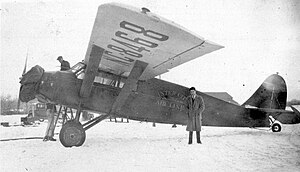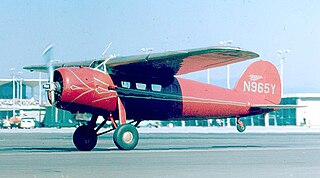
The Lockheed Vega is an American five- to seven-seat high-wing monoplane airliner built by the Lockheed Corporation starting in 1927. It became famous for its use by a number of record-breaking pilots who were attracted to its high speed and long range. Amelia Earhart became the first woman to fly solo across the Atlantic Ocean in one, and Wiley Post used his to prove the existence of the jet stream after flying around the world twice.
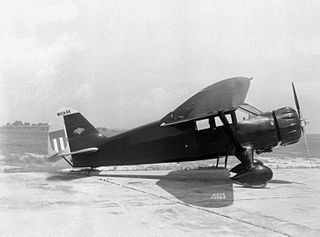
The Stinson Aircraft Company was an aircraft manufacturing company in the United States between the 1920s and the 1950s.

The Stinson Reliant is a popular single-engine four- to five-seat high-wing monoplane manufactured by the Stinson Aircraft Division of the Aviation Manufacturing Corporation of Wayne, Michigan.

The Wright R-975 Whirlwind was a series of nine-cylinder air-cooled radial aircraft engines built by the Wright Aeronautical division of Curtiss-Wright. These engines had a displacement of about 975 cu in (15.98 L) and power ratings of 300–450 hp (220–340 kW). They were the largest members of the Wright Whirlwind engine family to be produced commercially, and they were also the most numerous.

The Waco Aircraft Company (WACO) was an aircraft manufacturer located in Troy, Ohio, United States. Between 1920 and 1947, the company produced a wide range of civilian biplanes.

The Cunningham-Hall Model PT-6 was an American six-seat cabin biplane aircraft of the late 1920s and was the first design of the Cunningham-Hall Aircraft Corporation of Rochester, New York.
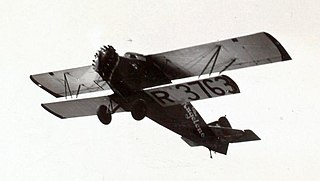
The Buhl AirSedan was a family of American civil cabin sesquiplane aircraft developed and manufactured by the Buhl Aircraft Company in the late 1920s. One example completed the first transcontinental non-stop roundtrip flight, made in 1929 by the CA-6 Spokane Sun-God, and the first Pope to have flown did so in a Buhl Airsedan.

The Faucett F-19 was a 1940s Peruvian eight-seat high-wing transport monoplane built by the airline Faucett Perú for its own use.

The Fairchild Model 41 Foursome was a light aircraft developed in the United States in the late 1920s and produced as the Model 42 Foursome. It was a conventional high-wing, strut-braced monoplane with fixed tailwheel undercarriage. The pilot and three passengers were seated within a fully enclosed cabin, and the aircraft generally resembled a scaled-down version of Fairchild's successful FC-2 design. Two prototypes were built as the Model 41 and Model 41A leading to the Model 42 production version which was built in a small series. This production version differed from the prototypes in having a redesigned, strut-braced empennage in place of the wire-braced unit of the earlier aircraft, and a more powerful version of the Wright Whirlwind powerplant.

The Potez 32 and its military version the Potez 33 was a single-engine monoplane transport design and built by the French aircraft manufacturer Potez. It was the first French-built medium-sized aircraft to see active use by both domestic and foreign airlines.

The Wright R-790 Whirlwind was a series of nine-cylinder air-cooled radial aircraft engines built by Wright Aeronautical Corporation, with a total displacement of about 790 cubic inches (12.9 L) and around 200 horsepower (150 kW). These engines were the earliest members of the Wright Whirlwind engine family.

The Stinson SM-6000 Airliner was a 1930s three-engined (trimotor) ten-passenger airliner designed and built by the Stinson Aircraft Corporation. The SM-6000 was a high-wing braced monoplane with room for a pilot and a cabin for ten passengers. It was powered by three 215 hp (160 kW) Lycoming R-680 engines strut-mounted one each side above the main landing gear units and one in the nose. A number of variants were built mainly with improved interiors. In 1932 the Model U Airliner was produced which had low-set stub wings with an engine mounted at each wingtip.

The Blackburn C.A.15C Monoplane and Biplane were a pair of British aircraft intended to be as similar as possible apart from their wing arrangement. Tests in 1933 did not favour either design conclusively.

The Spartan C4 was an American four-seat cabin monoplane designed and built by the Spartan Aircraft Company.
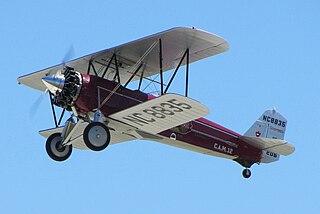
The Stearman C3 was an American-built civil biplane aircraft of the 1920s, designed by Stearman Aircraft of Wichita, Kansas. It was also the first Stearman aircraft to receive a type certificate.
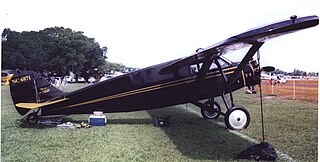
The Stinson Junior was a high-winged American monoplane of the late 1920s, built for private owners, and was one of the first such designs to feature a fully enclosed cabin.

The Spartan C3 is an American three-seat open-cockpit utility biplane from the late 1920s.

The Waco Standard Cabin series is a range of American single-engine 4–5 seat fabric covered cabin biplanes produced by the Waco Aircraft Company beginning in 1931 with the QDC and continuing until 1942 when production ended for the VKS-7F. They were used as light passenger and utility transports, navigational trainers, bushplanes and briefly as maritime reconnaissance aircraft during World War 2.

The Curtiss/Curtiss-Robertson Model 56 Thrush was a 1929 six passenger high-wing fixed undercarriage single-engine cabin monoplane airliner and utility transport powered by either a Curtiss Challenger or a Wright Whirlwind radial engine and built as an enlargement of the earlier Curtiss Robin. Several were used for record breaking endurance flights by female pilots during the early 1930s including one in which the aircraft stayed aloft for almost ten days.
